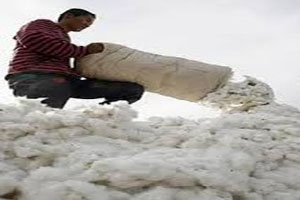
Indian cotton textiles
YarnsandFibers News Bureau 2018-03-27 10:49:00 – MumbaiThere is no specific quality standard on cotton quality in India, but quality per se of the cotton produced here is good as told by J Thulasidharan, President, Indian Cotton Federation.S Dhananjayan, senior auditor and advisor to Tirupur Exporters’ Association,said the knitwear cluster had to conform with various compliances such as ZLD and social compliance, which, in turn, resulted in a 10-15 per cent rise in production cost, making the operations unviable.he also said that, “This condition (of ZLD) is imposed only in western Tamil Nadu. Further, the processing sector is capital intensive, and the margins – practically nil.
â€Rising income and the “natural†fibre status would increase the demand for cotton. “The domestic demand is given, but the challenges in supply could impact. As India integrates with the global market, the stakeholders must take a 360 degree vision, as the cotton prices here will be decided by what is happening globally.†said G Chandrasekhar, commodities market specialist
“The market size is huge at ₹65,000 crore and in 2017-18, the risk cover was only to the extent of ₹9,000 crore,†Deepak Mehta, Head – Agri & Energy, MCX said, encouraging the participants to use the MCX platform more aggressively. He also made it clear that that price risk management is important for the cotton sector.
Susindaran, Chief Executive Officer, Kay Ventures said that “The spinning sector has established a benchmark, but scaling is required in post-spinning operations, particularly in weaving, processing, knitting and garmenting. Though not at the scale of operations in China, there is a need to scale up in garmenting. Lack of access to capital and the size of operation has put them in a disadvantageous position.â€
Such issues were discussed at a panel discussion on “Is Indian Cotton textiles losing its competitiveness?†From scale of operation to poor expansion or investment in post-spinning operations — be it weaving or processing, rising labour costs, inconsistent fibre policy, lack of level playing field to remain competitive on the export front, inordinate delay in signing of FTAs (Free Trade Agreements) and the inefficient supply chain seems to have pushed the cotton textile industry in the country to a tight spot.
In processing, the challenges faced by the industry are innumerable, on account of zero liquid discharge (ZLD). “We are now converting water pollution to air pollution,†he said in a lighter vein, before adding that the ZLD had pushed the cost of production northward by 20-25 per cent as told by Suresh Manoharan, Secretary, Perundurai SIPCOT Textile Processors’ Association
The garment sector in the textile value chain is at its lowest ebb, losing out to low cost countries such as Vietnam and Bangladesh, as they enjoyed LDC (Least Developed Countries) status. “The LDC has given these countries an edge over our exports. Exports from these countries are cheaper 10 per cent at the threshold level and there is no social compliance.â€said Prabhu Damodharan, Secretary, Indian Texpreneurs Federation (ITF).
Market Intelligence
Ask for free sample Report

experience
Customer Base
dedicated team
Countries Served Worldwide









